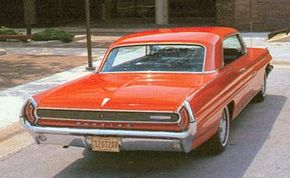The 1962-1964 Pontiac Grand Prix achieved strong sales for General Motors during its run, thanks in part to two influential GM executives. If the 1963 Pontiac Grand Prix testified to the design brilliance of General Motors styling chief Bill Mitchell, the original '62 model testified to the marketing brilliance of Semon E. "Bunkie" Knudsen. The Grand Prix was, in fact, Knudsen's parting gift after six years as division general manager during which the Pontiac Grand Prix rose from sixth in industry sales to a strong fourth and finally third for '62 -- a stellar achievement for a medium-price make.
In creating the Grand Prix, Bunkie took his cue from the high success of Ford's post-1957 four-seat Thunderbirds. The idea was simplicity itself: a Catalina hardtop coupe with unique styling touches and a T-Bird-type buckets-and-console interior. Interestingly, the new model was conceived for the Ventura nameplate, and it effectively replaced that slow-selling Catalina-based series. But Grand Prix was an inspired choice, with its heroic images of Formula 1 competition -- and, of course, its literal French meaning, "great prize."
Advertisement
Differences from the parent Catalina were quite modest: slightly revised grille; dummy back-panel grillework; the Catalina's optional front bucket seats as standard; and a shiny center console with tachometer, gauge package, and monochrome color scheme inside and out. But the whole was far greater than the sum of these parts. As Motor Trend stated: "Style-wise and price-wise [the Grand Prix] competes directly with the Thunderbird. Performance-wise, it's in a class by itself."
True enough. There were no fewer than five versions of Pontiac's superb Trophy 389 V-8, from a 230-horsepower economy special to a high-compression Tri-Power job (three two-barrel carburetors) with a hefty 348 blip. Speaking of heft, less weight and more available power gave the GP a decided performance edge on the Thunderbird. MT reported 0-60 mph taking a brief eight seconds.
Three-speed manual shift was standard, but most GPs were ordered with "Roto" Hydra-Matic, a new three-speed torque-converter automatic shared with Catalina, priced at $231. For the same money, confirmed leadfoots could specify four-speed manual floorshift, as well as seven different axle ratios.
For more information on cars, see:
- Classic Cars
- Muscle Cars
- Sports Cars
- Consumer Guide New Car Search
- Consumer Guide Used Car Search
Advertisement

